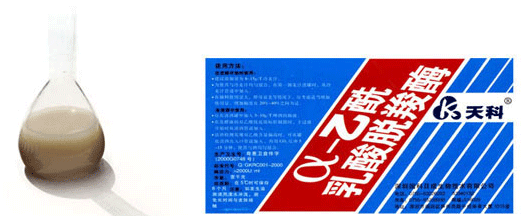Products

I. Physical appearance and main technical specifications
Physical appearance |
Light brown milky missible oil, no sediment, slight odor of microbe medium |
PH |
Lead¡Ü |
As¡Ü |
Enzyme activity unit u/ml |
2800 |
5.5-7.0 |
1.0ppm |
0.5ppm |
2300 |
||||
1600 |
||||
Total live bacteria count cfu/ml |
¡Ü3000 |
|||
Coliform MPN/100ml |
£¼3000 |
|||
Pathogens |
Not found |
|||
One enzyme activity unit is the amount of ALCD required to yield 1¦Ìmol of acetoin per minute, under specified conditions of 30¡æ, pH 6.0.
II. Packing, storage and transportation
Plastic bottle, net weight 1kg/bottle, 15 bottles/case, net weight 15kg/case.
Transport and store in cool and dry place and prevent from rain, moisture and sunlight.
If stored at 5¡æ, the enzyme activity will retain above indicated value for 6 months.
III. Applications and features
Prohibits or reduces the formation of dual-acetyl in beer and ensures the good flavor of beer.
Controls the dual-acetyl rebound in beer to avoid the effective on the flavor.
Greatly reduce fermentation period. The initial and post fermentation cycle can be reduced to about 10 days.
Increases output, equipment utility and benefits and significantly reduces costs.
IV. Using methods
When used in initial fermentation:
1. Suggested usage amount: 10-15m1/T cold wort.
2. To ensure proper mixing, add small amount of ALDC uniformly in batches from cold wort pipe. when the first liquid get into the tank.
3. When operating on large batches, or if the yeast cis weak in activity, consider increasing the dosage of 20-40%.
Suitable for sake:
1. Add 4-10ml/T in bright beer tank.
2. When the dual-acetyl nears the QC limit, add ALDC in the bright beer pipe when the filtration starts.
3. When the dual-acetyl nears the QC limit, add ALDC in the bright beer pipe when the filtration starts. When the dual-acetyl product level is high, add ALDC through the bottom of the cleaning tank, and inject CO. Bubble through for 5-10 minutes to mix them thoroughly.
V. Working principle and influencing factors
As ¦Á-acetolactate decarboxylase is used in beer fermentation, it directly transforms ¦Á-acetolactate, the precursor of dual-acetyl products, into 3-hydroxyl-2-butyric ketone. It catalyzes the decarboxylation of ¦Á-acetolactate to acetoin, thereby prevent the formation and build up of dual-acetyl products, and result in a dramatic shortening or even elimination of maturation period.



